Electric rickshaw
Electric rickshaws (also known as electric tuk-tuks,[1] e-rickshaws,[2] totos[3] and e-tricycles[4]) are small 3-wheeled vehicles powered by a battery-powered electric motor ranging from 650 to 1,400 watts (0.87 to 1.88 hp). These small electric vehicles save on fuel costs compared to auto rickshaws while offering greater mobility than pulled rickshaws, and thus has led to their popularity and widened acceptance in some cities since 2008. These electric rickshaws are mostly manufactured in India, Bangladesh, Nepal and China.[5][6]
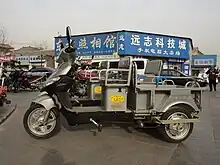
Development of E-Rickshaw market in India
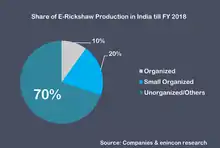
Share of Production [7]
Electric rickshaws gained popularity in India between 2015 and 2018. Although a host of unorganized producers dominate this segment, established manufacturers have also identified their growth opportunities and are expected to foray into the segment.
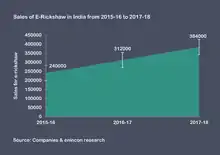
Sales Trends [7]
Though e-rickshaws were introduced in India on the lines of China in the late 2010s, sales were very sporadic and not widespread. Driven by the push for a greener transport industry (especially in tier-2 and tier-3 cities), the e-rickshaw market is widely gaining popularity and is likely to become more foundational to the transportation industry as more established producers enter into the segment.[8]
Design and construction
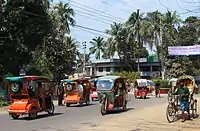
These rickshaws have a mild steel tubular chassis, consisting of three wheels with a differential mechanism at the rear wheels. The motor is a brushless DC motor. The electrical system used in Indian versions is 48V and in Bangladesh is 60V. The body of the most popular Chinese version is made of very thin iron or aluminum sheets. Bodies made of fiberglass are also popular for its strength and durability, resulting in low maintenance needs.[9]
The vehicle's batteries are typically lead acid with a lifespan of 6–12 months. Deep cycle batteries designed for electric vehicles are rarely used.[10]
Types
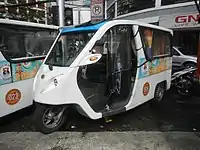
Load carriers
The load-carrying versions of these rickshaws differ in their upper body, load-carrying capacity, motor power, controller, and other structural aspects. At times, the motor power is also increased to carry loads up to 500–1000 kg.
Solar
There are two types of solar vehicles:
- Directly solar-powered — fitted with solar panels. A directly solar-powered rickshaw is an electric auto rickshaw driven solely by one or more electric motors, powered by solar panels mounted on the vehicle and capable of operating while the vehicle is in motion. Theoretically, solar panels could provide power directly to the motor(s) without the need for batteries, but in reality, this would be an improbable design choice for a rickshaw, given its intended purpose. In e-rickshaws, however, solar panels are not effective and are not frequently used.
- Indirectly solar-charged — In practice, the term solar rickshaw is most commonly used to describe battery-electric rickshaws whose batteries are indirectly solar-charged (i.e., independently of the vehicle) prior to use. This is usually facilitated by removing batteries in need of charging from the vehicle and exchanging them for batteries that have already been charged. Alternatively, batteries can be charged in-situ while the vehicle is parked, although this may limit daytime usage. The same battery replacement and in-situ charging methods are also used for non-'solar' batteries and vehicles.[11]
Popularity
Electric rickshaws are most popular in Asia, especially in China, India, Bangladesh and Nepal. The low-cost Chinese models were the first electric rickshaws to become popular in those countries. China, Japan, India, and European countries (Switzerland, France, and Germany) have researched and developed electric tricycles for commercial transport and are attempting to capture the growing market in Asia. The government has made efforts though to run them and made plans to issue licenses on a fee of 1.5tk, but there has been no action on this matter to date.[12]
Bangladesh
Bangladesh imports electric rickshaws directly from China or via other countries. The well-established cities prefer them as cheaper and better means of transport. The government, in an inter-ministerial meeting on 5 May 2011, banned the import and assembly of the vehicles and decided to send off-road those already plying, primarily on the ground that it consumes electricity mostly through illegal connections.[12]
China
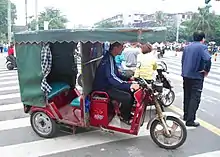
China is the largest manufacturer of electric rickshaws in the world, due to low labor costs, high production rates and encouraging government policies on foreign trade, they import a large number on a daily basis. There are hundreds of electric rickshaw manufacturers and thousands of parts producers. Their main market is within small towns or cities with insufficient public transport.[6]
India
One of the first attempts to design electric rickshaws was done by Nimbkar Agricultural Research Institute in the late 1990s.[13][14] In India, these e-rickshaws are widely spread all over the country, starting to gain popularity around 2011. The design is now much different from cycle rickshaws.
Today, e-rickshaws play a vital role in providing livelihood to people in India. Due to their low cost and high efficiency, they are accepted on the Indian streets,[15] but government policies have been threatening the e-rickshaw and banned its use in the capital city Delhi,[15][16] but failed to put them off the streets. E-rickshaws are still rising in number and are widely used in Delhi and other parts of India. In Delhi, as per government official figures in April 2012, their number was over 100,000.[6][17]
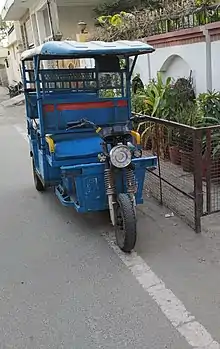
E-rickshaw law in India
Initially, e-rickshaws were unregulated by any central law in India. However, the Delhi High Court banned the running of e-rickshaws in Delhi on 31 July 2014 over safety concerns raised through public interest litigation.[18] In a rally held for regularization of e rickshaws in Delhi, transport minister Nitin Gadkari said that "municipal corporations would regularize e-rickshaws by registering them for a fee of just ₹100. After registering the e-rickshaw, corporations will have to issue identity cards to drivers so that they can earn their livelihood easily."[19] Once the policy was in place, the corporation, along with traffic police, would have fixed the amount of the fine to be imposed for violation of the policy.[19] However, the policy was never implemented. Certain states like Tripura had regularized the e-rickshaws through municipal bylaws or through state legislation.[18] In March 2015, the Indian Parliament passed an amendment to the Motor Vehicles (Amendment) Bill, 2015 legalizing e-rickshaws.[20] By July 2015, battery rickshaws are available for travel in many cities and are now certified to ply with Registration No. plate by R.T.O. with insurance.
See also
References
- "Tripura to register battery-operated rickshaws". Zee News. 25 June 2014. Retrieved 18 September 2014.
- Mohammad, Anas (21 October 2014). "Meet Tabassum Bano - the first female e-rickshaw driver of Allahabad". I am in DNA of India. Allahabad. Archived from the original on 29 October 2014. Retrieved 20 October 2014.
{{cite news}}: CS1 maint: unfit URL (link) - "'Invention of Toto a stellar achievement'". The Times of India. Retrieved 25 March 2019.
- Agaton, Casper Boongaling; Collera, Angelie Azcuna; Guno, Charmaine Samala (2020). "Socio-Economic and Environmental Analyses of Sustainable Public Transport in the Philippines". Sustainability. 12 (11): 4720. doi:10.3390/su12114720.
- "It's cheaper: Dealers import rickshaw parts from China, assemble them here". The Indian Express. 20 March 2014. Retrieved 10 December 2016.
- Jamil, Faiz. "Regulation threatens India's e-rickshaws". Al Jazeera. Retrieved 10 December 2016.
- "2 & 3 Wheeler Electric Vehicle Market in India and Future Outlook 2022 Report Flyer" (PDF). Enincon. Archived from the original (PDF) on 23 April 2019.
- "E-rickshaws run in Assam & Tripura, why not Arunachal?". Arunachal Observer. 22 February 2022. Retrieved 5 August 2023.
- Electric, Team Biliti (10 June 2023). "How E-Rickshaws (Electric Tuk-Tuks) Work: A Brief Overview". Blog - Biliti Electric. Retrieved 5 August 2023.
- "Electric Vehicles Today & Tomorrow; Indian prospective of E-rickshaws". Capco Industries. Retrieved 5 August 2023.
- "Greenuadimfrom". greenuadimfrom.ml. Retrieved 31 May 2019.
- "Electric rickshaws run out of steam". The Daily Star. 30 May 2011. Retrieved 10 December 2016.
- Rajvanshi, Anil K. (25 September 2002). "Electric and improved cycle rickshaw as a sustainable transport system for India". Current Science. 83 (6): 703–707. JSTOR 24106145.
- "#Innovation: These Amazing Modified Cycle Rickshaws Are Making The Task Easier For Rickshaw Pullers". 18 December 2014.
- Bose, Pratim Ranjan (14 February 2014). "Cheap rides, low costs: it's Tuk-Tuk time in Tripura". Business Line. Retrieved 10 December 2016.
- "Govt stops sale of e-rickshaws". The Indian Express. Retrieved 10 December 2016.
- Mehta, Nikita (6 February 2014). "Industry". LiveMint. Retrieved 10 December 2016.
- Harding, Simon; Rojesh, Seram (31 August 2014). "Battery Rickshaws in New Delhi and the Regulation Conundrum". Economic and Political Weekly. XLIX (35). Retrieved 15 September 2014.
- "Municipal corporations to frame policy on e-rickshaws in a month's time". The Economic Times. Retrieved 10 December 2016.
- "E-Rickshaw Bill Passed". 10 March 2015. Retrieved 10 December 2016.
- Shacket, Sheldon R. The Complete Book of Electric Vehicles. Northbrook, IL: Domus Books, 1979.
- Whitener, Barbara. The Electric Car Book. Louisville, KY: Love Street Books, 1981.
- Regulation threatens India's e-rickshaws
- Govt stops sale of e-rickshaws - Indian Express
- Electric rickshaws run out of steam
- It’s cheaper: Dealers import rickshaw parts from China, assemble them here
- Delhi Auto Expo: India chases electric mobility dream
- Cheap rides, low costs: it’s Tuk-Tuk time in Tripura
- How electric automobile is made - material, manufacture, making, history, used, parts, components, steps, product
- Chakraborty, Abhishek (4 June 2016). "E-DRIVE - Electrie, Electeca bet big on Bengal". The Times of India. Archived from the original on 18 March 2017.
- Municipal corporations to frame policy on e-rickshaws in a month's time
